Introduction: An Artist of Amsterdam
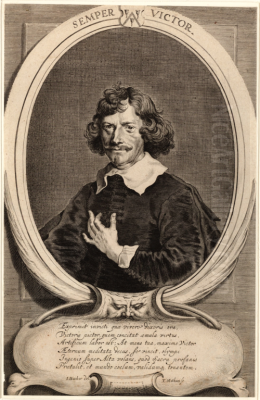
Jan Victors (c. 1619/1620–1676) stands as a notable figure within the vibrant artistic landscape of the Dutch Golden Age. Born in Amsterdam, the bustling heart of the Dutch Republic, Victors carved out a significant career primarily focused on historical and biblical narratives, particularly scenes drawn from the Old Testament. His style was deeply marked by the towering influence of Rembrandt van Rijn, placing him firmly within the circle of artists who responded to the master's dramatic use of light and psychological depth. Though details of his life remain somewhat scarce, his surviving works testify to a skilled painter who catered effectively to the tastes and religious sensibilities of his time, before his life concluded far from home in the Dutch East Indies.
Early Life and Artistic Formation in Amsterdam
Jan Victors entered the world in Amsterdam around 1619 or 1620. His family background was rooted in craftsmanship rather than fine art; his father and grandfather were carpenters, and his mother was involved in textile work. This connection to artisanal trades perhaps fostered an appreciation for skilled making, though his path led towards painting. The specifics of his artistic training are not definitively documented, leading to some scholarly speculation.
One prominent theory suggests Victors may have received instruction from Pieter Lastman, who had famously been Rembrandt's own teacher. This potential tutelage might have occurred between 1637 and 1639. During this period, Amsterdam was a crucible of artistic activity. Regardless of direct apprenticeship, Victors's development was undeniably shaped by the prevailing artistic currents, most significantly by Rembrandt and his immediate circle. Influences from artists like Govert Flinck, himself a pupil of Rembrandt, are clearly discernible in Victors's approach. Gerard van den Eeuckhout, another artist associated with Rembrandt, was also active in Amsterdam during Victors's formative years, contributing to the rich artistic environment he navigated.
Artistic Style: Rembrandt's Influence and Individual Expression
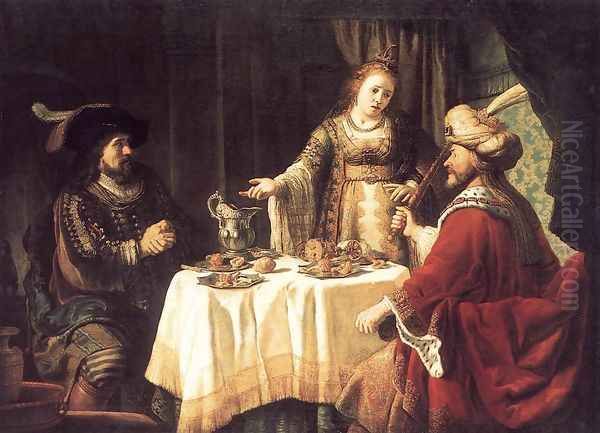
Jan Victors's art belongs stylistically to the Baroque period, infused with the particular character of Dutch painting in the 17th century. The most defining influence on his work is unquestionably Rembrandt. This is evident in his dramatic compositions, his use of chiaroscuro (strong contrasts between light and dark) to heighten emotion and focus attention, and his interest in conveying the psychological state of his figures through expression and gesture. His paintings often feature figures in dynamic poses, engaged in moments of significant narrative tension.
However, Victors was not merely an imitator. He developed his own distinct artistic personality. His works are often characterized by a meticulous attention to detail, particularly in the rendering of fabrics, costumes, and accessories, which lend an air of richness and specificity to his scenes. His colour palette could be vibrant, and his application of paint often smoother than Rembrandt's later, more textured style. Some art historians also note similarities in the lively gestures and expressions in his work to earlier Dutch history painters like Pieter Lastman and Claes Moeyaert, suggesting a synthesis of influences beyond just Rembrandt.
Subject Matter: A Focus on the Old Testament
While Jan Victors tackled various subjects throughout his career, he became particularly renowned for his depictions of Old Testament narratives. Stories from Genesis, Exodus, the Books of Kings, and the story of Esther were recurrent themes. This specialization resonated strongly with the cultural and religious climate of the Dutch Republic, particularly among its Calvinist or Presbyterian communities. Calvinism placed a strong emphasis on the direct study and understanding of the Bible, and paintings depicting these sacred stories served as visual aids for contemplation and moral instruction.
Victors's ability to render these familiar tales with dramatic flair and emotional resonance made his work highly sought after by patrons who valued biblical literacy and piety. His paintings often focus on moments of moral decision, divine intervention, or intense human interaction drawn directly from the scriptures. The clarity of his storytelling, combined with the richness of his execution, suited the tastes of collectors who appreciated both religious content and artistic skill.
Masterpiece: The Banquet of Esther and Ahasuerus
Among Jan Victors's most celebrated works is The Banquet of Esther and Ahasuerus. This painting, housed in the Gemäldegalerie Alte Meister in Kassel, Germany, exemplifies many key aspects of his artistry. It depicts the dramatic moment from the Book of Esther where Queen Esther, during a banquet she prepared for King Ahasuerus and his advisor Haman, reveals Haman's plot to annihilate the Jewish people.
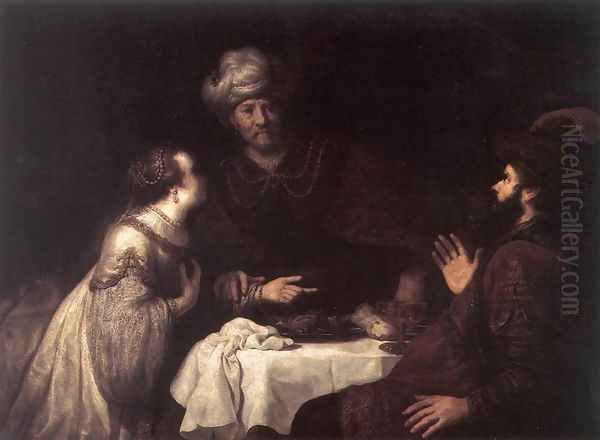
The composition is typically Baroque in its dynamism and emotional intensity. Victors captures the tension of the scene, focusing on the interactions and expressions of the main figures: Esther's courageous plea, Ahasuerus's dawning realization and anger, and Haman's shock and fear. The lavish details of the banquet setting, the rich costumes, and the play of light across the figures showcase Victors's skill in detailed rendering and creating a compelling, theatrical atmosphere. This work highlights his ability to translate complex biblical narratives into powerful visual statements.
Other Significant Biblical Works
Victors explored the story of Esther in other compositions as well, such as Esther and Haman before Ahasuerus, further demonstrating his engagement with this narrative of courage and deliverance. Another notable theme he addressed is found in works like Ruth and Naomi. This subject, depicting the loyalty and devotion between the Moabite Ruth and her Israelite mother-in-law Naomi, allowed Victors to explore themes of familial piety and faithfulness, again rendered with characteristic attention to emotional expression and detailed depiction of figures and attire.
These works, alongside numerous others depicting scenes like Joseph interpreting dreams, the dismissal of Hagar, or episodes from the lives of the patriarchs, solidify Victors's reputation as a leading interpreter of Old Testament stories in the Dutch Golden Age. His consistent focus on these narratives suggests a personal affinity or, more certainly, a successful catering to a specific market demand among devout collectors.
Beyond the Bible: Genre Scenes and Portraiture
While best known for his biblical paintings, Jan Victors's oeuvre was not limited to religious subjects. He also produced genre scenes, depicting aspects of everyday life in the Dutch Republic. These works often focused on village life, artisans at work (perhaps reflecting his own family background), or market scenes. These paintings showcase his keen observation of social customs, clothing, and human interaction in more mundane settings.
Furthermore, Victors painted portraits and historical scenes that were not explicitly biblical. His skill in capturing likenesses and rendering textures served him well in portraiture, although fewer examples survive or are firmly attributed compared to his narrative works. His historical paintings allowed him to engage with different kinds of dramatic storytelling. This versatility demonstrates a broader artistic range, even if his primary legacy remains tied to his religious output.
Victors in the Artistic Landscape of Amsterdam
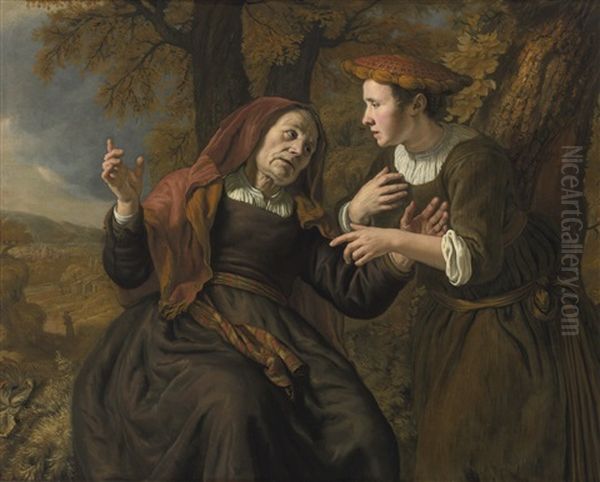
Jan Victors operated within the thriving, competitive art world of mid-17th century Amsterdam. His connection to Rembrandt, whether as a direct pupil or simply a strong follower, placed him within an influential artistic network. He was clearly familiar with the work of Rembrandt's successful students, such as Govert Flinck, whose style also shows a blend of Rembrandtesque drama with a smoother, more classicizing finish that sometimes appears in Victors's work.
Other prominent artists from Rembrandt's circle, like Ferdinand Bol or the aforementioned Gerard van den Eeuckhout, were his contemporaries in the city. While direct collaborative evidence is lacking, these artists shared influences, patrons, and a market, creating an environment of both competition and shared artistic language. Victors successfully navigated this environment, establishing his own niche, particularly with his focus on Old Testament themes presented in a clear, dramatic, and richly detailed manner.
Connections and Contemporaries: Documented and Undocumented
Despite the strong stylistic influence, there is no definitive documentary proof that Jan Victors was formally apprenticed to Rembrandt or had a close personal relationship with him. Art historical analysis relies on stylistic comparison and the known timelines of artists active in Amsterdam. This contrasts with figures like Jan Lievens, whose early career in Leiden involved a well-documented period of intense artistic exchange, friendship, and rivalry with the young Rembrandt.
Similarly, while Frans Hals was a towering figure in Dutch portraiture during the Golden Age, primarily active in Haarlem, there is no known record or evidence suggesting any direct interaction or collaboration between Hals and Victors. Rembrandt's documented relationship with patrons like Jan Six, whom he famously etched, provides another example of the kind of specific connection for which evidence is lacking in Victors's case regarding major figures like Rembrandt or Hals. Victors's primary connections seem rooted firmly within the broader circle influenced by Rembrandt's Amsterdam workshop.
The Wider Context of the Dutch Golden Age
To fully appreciate Jan Victors, it's helpful to place him within the extraordinary flourishing of arts and culture known as the Dutch Golden Age. This period, roughly spanning the 17th century, saw the newly independent Dutch Republic become a global center of trade, science, and art. This prosperity created a broad market for paintings, extending beyond the church and aristocracy to wealthy merchants, guilds, and citizens.
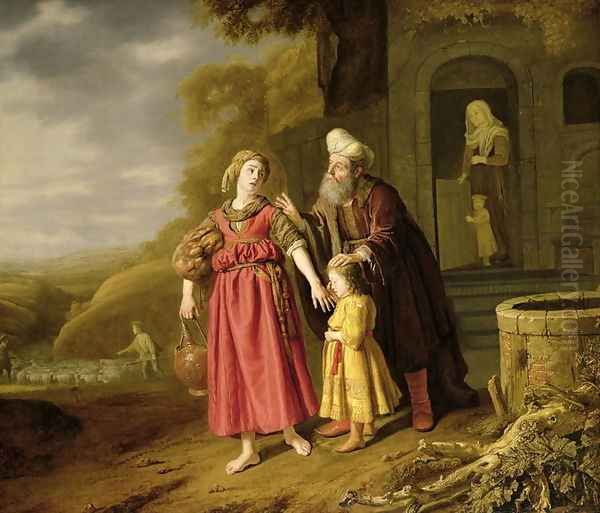
This era produced artists of immense talent and varied specializations. Alongside Rembrandt's profound explorations of history and the human psyche, Johannes Vermeer captured serene moments of domestic life with unparalleled mastery of light and composition in Delft. Frans Hals brought portraits to life with energetic brushwork in Haarlem. Countless other artists specialized in landscapes, seascapes, still lifes, and genre scenes, reflecting the diverse interests of Dutch society. Victors contributed to this rich tapestry with his particular focus on narrative history painting, primarily biblical, executed in a style accessible yet indebted to the era's greatest master.
Later Years and Departure
Information about Jan Victors's later career becomes sparser. The Dutch art market experienced a significant downturn following the Rampjaar (Disaster Year) of 1672, when the Republic was invaded by France, England, and German principalities. This economic hardship severely impacted many artists, potentially including Victors.
Whatever the precise reasons, Victors eventually left the Netherlands. Records indicate that he took up a position as a ziekentrooster (comforter of the sick), a lay religious role, with the Dutch East India Company (VOC). He sailed for the Dutch East Indies (present-day Indonesia) and died there in 1676. This late-life career change, moving from professional painter in Amsterdam to a religious caregiver in Asia, remains a poignant and somewhat mysterious endnote to his artistic life.
Academic Reception and Legacy
In art history, Jan Victors is recognized as a significant painter of the Dutch Golden Age, particularly valued for his contributions to biblical painting. He is often discussed in the context of Rembrandt's influence, considered one of the more accomplished artists who adapted elements of the master's style for a broader audience. His works are held in major museum collections worldwide, including the Rijksmuseum in Amsterdam, the Louvre in Paris, and the aforementioned Kassel State Museums, attesting to his historical importance.
Scholarly research continues to explore his oeuvre, attributions, and the precise nature of his relationship with Rembrandt and other contemporaries. While acknowledging his skill and the appeal of his work, especially to Calvinist patrons, academic assessments also note the remaining uncertainties about his biography and training. He is generally regarded as a talented and productive artist who successfully carved out a career within the demanding Amsterdam art market, leaving behind a substantial body of work characterized by dramatic storytelling and detailed execution.
Conclusion: A Distinct Voice in Rembrandt's Shadow
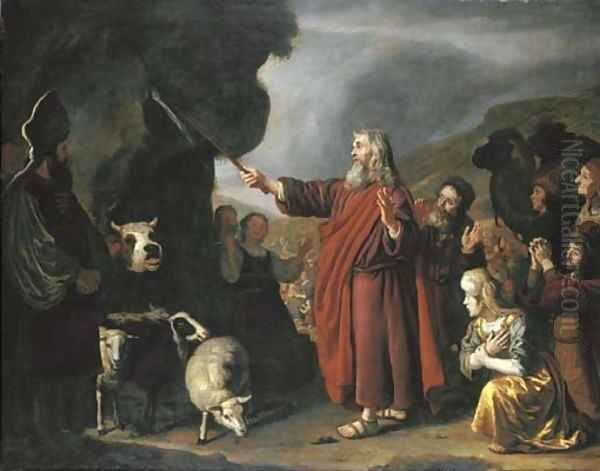
Jan Victors remains an important figure for understanding the breadth and depth of Dutch Golden Age painting. As an artist deeply influenced by Rembrandt, he translated the master's dramatic intensity into a more polished and detailed style that found favour with patrons seeking compelling visual interpretations of biblical narratives. His focus on the Old Testament, combined with his skill in depicting expressive figures and rich settings, secured his place in the Amsterdam art scene. Although overshadowed by the towering genius of Rembrandt, and despite biographical gaps, Jan Victors stands on his own merits as a skilled storyteller in paint, whose works continue to engage viewers with their narrative power and careful craftsmanship, offering a distinct voice from a remarkable era in art history.